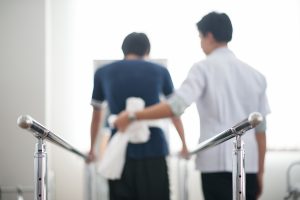Rehabilitation
Our Rehabilitation Department offers
“A Comprehensive Approach to Delivering Quality Care with a Personal Touch”
The Rehabilitation Department at Slocum-Dickson Medical Group consists of highly professional, experienced, and trained staff that assist patients in reaching their rehabilitation goals and potential.

We practice evidence-based medicine and attend regular continuing education courses to keep up with advances in our profession.
Hours of Operation
Burrstone Campus
Monday – Friday:
7:30 am – 6:00 pm
Treatment & Services
Therapy Services Include:
Specializing in the Treatment of:
- Treatment with various modalities for relief of pain and inflammation
- Individualized stretching, strengthening, and conditioning programs to regain your functional loss.
- McKenzie evaluations and treatments are provided by certified McKenzie practitioners. Low Back Pain educational information.
- Vestibular Therapy focused on reducing vertigo/dizziness.
- Orthopedic & Sports Medicine Injuries
- Lower Back Pain & Neck Pain
- Arthritic Conditions
- Headaches
- Post-Fracture Management
- Tendonitis / Bursitis
- Strains and Sprains
- Balance Disorders / Dizziness / Vertigo
Treatment & Services
Therapy Services Include:
- Treatment with various modalities for relief of pain and inflammation
- Individualized stretching, strengthening, and conditioning programs to regain your functional loss.
- McKenzie evaluations and treatments are provided by certified McKenzie practitioners. Low Back Pain educational information.
- Vestibular Therapy focused on reducing vertigo/dizziness.
Specializing in the Treatment of:
- Orthopaedic & Sports Medicine Injuries
- Lower Back Pain & Neck Pain
- Arthritic Conditions
- Headaches
- Post-Fracture Management
- Tendonitis / Bursitis
- Strains and Sprains
- Balance Disorders / Dizziness / Vertigo
- RSD
- Gait Evaluations
Physical Therapy
Slocum-Dickson Physical Therapy consists of a complete and thorough evaluation of your medical diagnosis by a licensed therapist. A comprehensive, rehabilitative treatment program will be designed by your therapist with the use of physical agents and therapeutic exercise to prevent and reduce various traumatic, genetic, degenerative and infectious processes. You will have the opportunity to ask questions regarding your conditions and take an active part in you rehabilitation goals.
